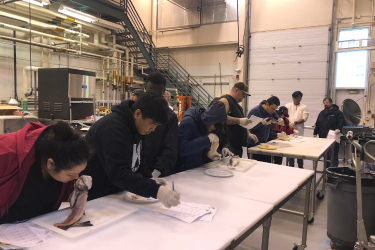Mark Grace, a biologist with NOAA’s Southeast Fisheries Science Center, was in the lab processing specimens collected from the deep waters of the central Gulf of Mexico when he came across an animal he didn’t recognize.
“I knew it was a species of shark,” Grace said of the odd-looking, 5-1/2 inch long creature with a bulbous head and rows of sharp, tiny teeth. “But I’d never seen anything like it before.”
The creature would turn out to be an incredibly rare find, only the second known specimen of pocket shark, a group named for the two small pockets above their pectoral fins.
Much about the pocket shark, including what those pockets are used for, remains a mystery. The usual next step would be to dissect the creature, but given the rarity of this specimen, that’s not an option.
So instead, scientists have created high-resolution computed tomography scans (also known as CT scans) of the pocket shark and put them online. Now any scientist—or anyone with an internet connection, for that matter—can study the anatomy of the pocket shark in stunning, three-dimensional detail.
High Resolution, Three-dimensional Imaging
The CT scan was created by biologist John Denton and colleagues at the American Museum of Natural History. Denton uses CT scans to study the anatomy of fishes and their evolutionary relationships, and he is an expert on bioluminescent deep sea fishes, of which the pocket shark is one. The images are hosted at the online database http://sharksrays.org, which was created by Gavin Naylor and his students at the College of Charleston.
The CT scanner at the museum is based on the same technology as scanners used in medical imaging, but it produces very high resolution images.
“You can isolate different parts of the anatomy—the skin, the jaw, the vertebrae—and rotate them in three dimensions,” Grace said. “It’s absolutely mesmerizing.”
The CT scans proved valuable when counting the vertebrae, the smallest of which were too small to be picked up using standard x-ray imaging, and when counting the teeth. Many teeth were missing, but by rotating the image of the jaw and examining its inner surface, Grace was able to count the tiny new teeth coming up to take their place.
Understanding the Ecology of the Deep Ocean
The pocket shark had been caught during a scientific survey to the Gulf of Mexico aimed at understanding the feeding behavior of sperm whales. Using sonar, scientists observed sperm whales diving to 3,000 feet, then used a net to sample the area where the whales were feeding. Those samples, including the pocket shark, were frozen for later identification.
The deep ocean habitat of the pocket shark is one of the least explored ecosystems on the planet—the dark realm where sperm whales stalk giant squid and alien-looking creatures emit a bioluminescent glow. The pocket shark is a reminder that we still live in an age of discovery.
The CT scans will help scientists interpret this second pocket shark discovery (the first, discovered nearly 30 years ago off the coast of Chile, is not in as good condition). The species appears to be closely related to cookie cutter sharks, which feed by taking bites out of the skin of larger animals.
The anatomy of the pocket shark’s jaws and teeth indicate that it inhabits a similar ecological niche. As for the pockets, they might emit a bioluminescent fluid to either attract mates or confuse predators. That’s just a hypothesis, however, and will likely remain that way until scientists can observe a pocket shark in action.
“I would love to see a pocket shark alive in its environment,” Grace said. “But the CT scans are the next best thing.”
More Information
To explore the 3-D scans, visit sharksrays.org.


